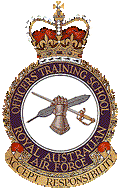| RAAF Officer Training School | |
|---|---|
 RAAF Officer Training School emblem | |
| Active | 1950–present |
| Branch | Royal Australian Air Force |
| Part of | Air Force Training Group RAAF College |
| Garrison/HQ | RAAF Base East Sale |
| Motto(s) | Accept Responsibility |
| Commanders | |
| Notable commanders | William Brill (1953–56) [1] |
Officers' Training School (OTS) is the unit responsible for preparing recruits, senior airmen and Warrant Officers for careers as commissioned officers in the Royal Australian Air Force (RAAF). Between 200 and 300 students graduate from the School each year, which is located at RAAF Base East Sale, Victoria.